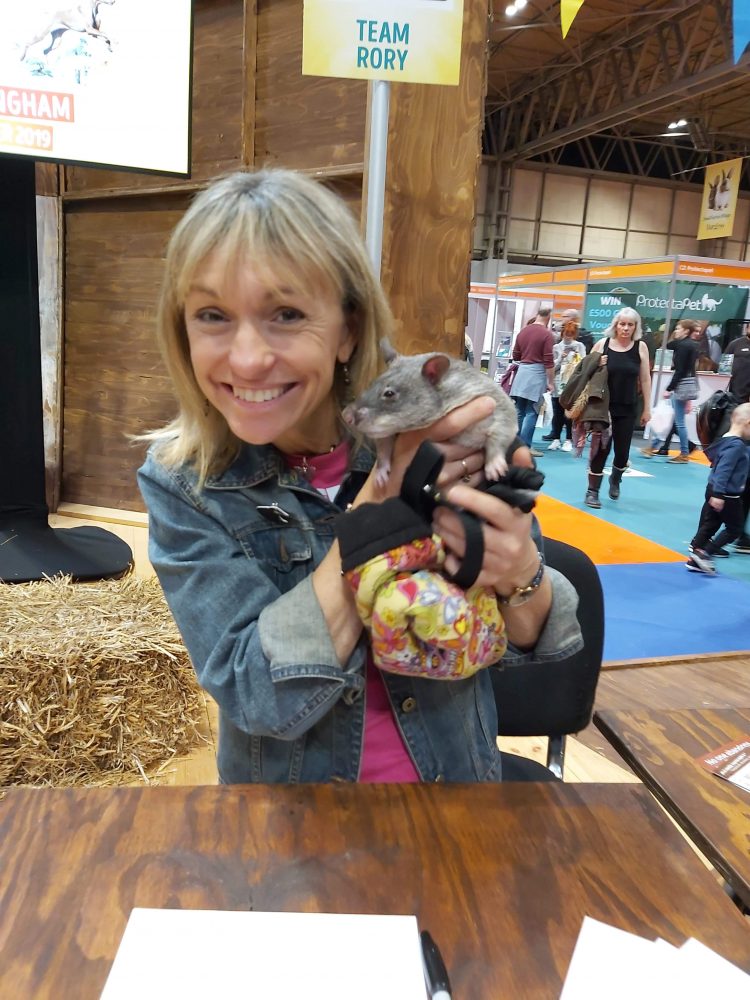Fact Sheet Index
Geographic Range
Habitat
Physical Description
Reproduction
Lifespan
Behaviour
Home Range
Communication
Food Habits
Predation
Ecosystem Roles
Other Comments
References
Kingdom: Animalia
Phylum: Chordata
Subphylum: Vertebrata
Class: Mammalia
Order: Rodentia
Suborder: Myomorpha
Family: Nesomyidae
Subfamily: Cricetomyinae
Genus: Cricetomys
Species: Cricetomys gambianus
Geographic Range
Gambian rats are found in central Africa, in regions south of the Sahara desert as far south as Zululand. This includes countries such as Nigeria among others.
Habitat
Gambian rats inhabit a variety of habitats ranging from arid areas to temperate areas, but need some form of shelter to survive. Therefore, they are not usually found in completely open areas, but in areas with cover from hollow trees, rock outcroppings, or burrows made by other animals. They are occasionally known to venture into urban areas and can become pest animals.
Physical Description
Mass: 1 to 1.47 kg (2.2 to 3.23 lbs)
Length: 645 to 910 mm (25.39 to 35.83 in)
Basal Metabolic Rate: 71 cm^3 oxygen/hour (average)
Gambian pouched rats are one of the world’s largest rats. Besides their large size, the most characteristic trait of Gambian pouched rats is the tail which is long, unscaled, and dark in color at the base with the terminal 40-60% white. The fur on the upper body is coarse and gray and often darker down the middle of the back. The fur color grades to a lighter gray on the flanks while the fur on the belly and the top of the feet is white or off-white. Dark brown or black patches of fur occur around the eyes and at the base of the whiskers. The naked rounded ear is large and the eyes are small, suggesting that the senses of smell and hearing which are acute may be more important than sight in this nocturnal. The hind feet are large and considered to be well adapted for digging Gambian pouched rats possess a pair of large cheek pouches. These pouches can expand to a great size, allowing Gambian rats to transport massive quantities of food if necessary.
Two species are currently recognized: Cricetomys gambianus, the Gambian pouched rat, and C. emini, Emins giant pouched rat.
The Emins is more slender and muscular in appearance with a longer face to the Gambian.
Other differences are in the fur texture and colour. The Emins upper body is smooth and the colour ranging from a dark brown to almost black with a distinct line break to the white underside.
Some key physical features: endothermic; homoiothermic; bilateral symmetry
Sexual dimorphism: sexes alike.
Reproduction
Breeding interval: Gambian rats breed seasonally
Breeding season: Breeding usually occurs in the summer
Number of offspring: 1 to 6
Gestation period: 30 to 32 days
Birth Mass: 25.70 g (average) (0.9 oz)
Time to weaning: 28 days (average)
Time to independence: 30 days (average)
Age at sexual maturity (female): 6 months (average)
Mating in Gambian rats involves the formation of a social pair-bond between one male and one female. The male usually sniffs or licks the urogenital areas of the female before attempting to mount the female. Gambian rats also display peculiar courtship behaviors. The male and female often stand upright and scratch one another, then chase each other until the female is ready for copulation. If the female is not receptive or rejects the male, she bites the male on the tail and back among other areas before courtship behaviors begin.
Gambian rats are seasonal breeders, usually breeding in the summer. The estrous cycle lasts between 3 and 15 days, while the length of estrus ranges from about 1.4 to 7.8 days. Interestingly, the estrous cycle is often irregular and seems dependent upon many external factors, the environment being one. Other factors include the presence of males, and captivity. Females reach sexual maturity at about 6 months and will typically have about 9 litters annually. The gestation period is approximately 30 to 32 days. Females are also very aggressive when giving birth to a litter.
Key reproductive features: iteroparous; seasonal breeding; gonochoric/gonochoristic/dioecious (sexes separate); sexual; viviparous.
Gambian rat young are born hairless, with eyes and ears closed. The characteristic long tail does not show substantial growth until about 30 to 35 days. The eyes do not open until about 21 days into development, although the young are completely covered with fur and have open ears at about 14 days. The female provides the most parental care, both as a source of warmth for the naked young and as a source of milk. The female also changes her food preference before the young are weaned, choosing softer foods. The male, on the other hand, shows almost no care to the young. It shows tolerance at best, and will sometimes kill it’s young and eat them. This is not seen as often in females. An interesting form of altruism exists amongst females, where a female with a separate litter may take care of a motherless litter.
Parental investment: altricial; pre-fertilization (protecting: female); pre-hatching/birth (protecting: female); pre-weaning/fledging (provisioning: female, protecting: female); pre-independence (provisioning: female, protecting: female).
Lifespan
Typical lifespan (captivity)
Gambian rats live for about 5 to 7 years in captivity, although some have been known to live as long as 8 years. Life expectancy in the wild is hard to document because of the small size of these creatures and because they are hunted so often by indigenous people.
Behavior
Gambian rats are nocturnal animals, mostly due to the fact that they have little or no tolerance for the intense heat of a typical African day. They are nearly inactive during the day, and come out at night in search of food. Gambian rats often use a vast system of tunnels or hollow trees for their nests, where they rest during the day and come out at night in search of food. These nests are often located in cool areas, providing more evidence for their intolerance to heat. Interestingly, Gambian rats find almost as much value in the act of carrying as much as the act of hoarding food. This results in confusing hoarding patterns when food is plentiful in any season. The pouches inside the cheeks of Gambian rats can hold over 100 ml when full and this allows Gambian rats to transport and extraordinary amount of material in a short period of time. Some studies have shown Gambian rats to transport 3 kg in two and a half hours. Gambian rats are also very good climbers and swimmers, and climb in excess of 2 meters easily. Both sexes are very territorial. Although Gambian rats are generally solitary in the wild, females often form large groups containing many mothers and their litters while males usually remain solitary. These rats adapt rapidly to new situations, such as captivity. Gambian rats have also been known to huddle together when temperatures drop. Due to their low body fat they do not retain heat easily.
Home Range
Although Gambian rats are usually passive and shy in the wild, they are very protective of their nests and are aggressive in defending it. However, outside of the nest, there is no truly defined home range.
Key behaviors: cursorial; nocturnal; motile; daily torpor; territorial; social.
Communication and Perception
Gambian rats use screeching as the main form of communication. Gambian rats emit one single short cry which is distinguishable from the longer, varied pitch of African giant pouched rats. Males also use olfactory cues during courtship when they sniff the urine left by female Gambian rats.
Food Habits
Gambian rats are hoarders, and carry as much food as they can fit inside the pouches located on the inner cheeks. They are omnivores and feed on a variety of fruits, vegetables, nuts, and even insects when available. Some common foods include cassava, beans, sweet potatoes, and other roots. Termites have been known to be eaten along with snails.
Primary Diet: omnivore.
Animal Foods: insects; mollusks.
Plant Foods: roots and tubers; seeds, grains, and nuts; fruit.
Foraging Behaviors: stores or caches food.
Predation
Known predators: humans (Homo sapiens)
There are no true predators in the wild that target Gambian rats. Although a few instances have been recorded where a bird of prey or another predator has eaten Gambian rats, they usually band together and are formidable opponents against potential predators. The biggest predator of Gambian rats is humans, the indigenous African population. These rats are considered a delicacy and are often hunted for food.
Gambian rats serve to keep insect populations under control, but also act as transporters of seeds from different plants when they eat the fruits produced. Several parasitic worms inhabit the gastrointenstinal tracts of these rats, but the most prevelant of these are the Strongyloides. A study performed also showed minor prescences of tape worms among other parasites. Other parasites include Xenopsylla cheopis, Aspicularis tetraptera, Ixodes rasus, and Ornithonyssus bacoti. Hymenolepis is usually found in the small intestine while Aspicularis is found in the rectum and colon.
Key ways these animals impact their ecosystem: disperses seeds.
Economic Importance for Humans: Negative
Gambian rats are sometimes considered pests in urban areas where they may infest the sewers. In rural areas, they may destroy farm crops and build burrows in the soil which lead to soil desiccation and loss of plant crops. Gambian rats often inhabit barns and other farm buildings which can lead to property damage.
Ways that these animals might be a problem for humans: crop pest.
Economic Importance for Humans: Positive
The biggest economic impact of Gambian rats is as a source of food in Africa. They are considered rather tasty and are hunted and even raised on farms for their meat. This had led to a significant drop in the population. A smaller industry is the pet industry, although these rats are rather large and sensitive to temperature changes, resulting in a need for high maintenance. In the scientific community, these rats are often used for experiments, and these rats provide a wealth of information on rodent physiology and behavior.
Ways that people benefit from these animals:pet trade; food.
Conservation Status: IUCN Red List
Least Concern: US Federal List.
Gambian rats are in danger of being overhunted, but due to their rapid generation time the population has not reached the levels of critically endangered or otherwise.
Research has shown that the cheek pouches of C. gambianus most likely evolved in parallel to those of Sciuridae and other members of the family Muridae.
Ajayi, S. 1977. Field observations on the African giant rat Cricetomys gambianus in southern Nigeria. East African Wildlife Journal, 15(3): 191-198.
Ajayi, S. 1977. Live and carcass weights of giant rat Cricetomys gambianus and domestic rabbit Oryctalagus cuniculus. East African Wildlife Journal, 15(3): 223-228.
Ajayi, S., O. Tewe, E. Faturoti. 1978. Behavioral changes in African giant rat (Cricetomys gambianus Waterhouse) under domestication. East African Wildlife Journal, 16(2): 137-143.
Amador, A. 2003. “ISAS” (On-line).
Bobe, L., M. Mabela. 1997. Incidence of four gastro-intestinal parasite worms in group of cricetomas, Cricetomys gambianus (Rodent: Cricetidae), caught it Lukaya- Democratic Republic of Congo. Tropicultura, 15(3): 132-135.
Dipeolu, O., S. Ajayi. 1976. Parasites of theAfrican giant rat Cricetomys gambianus in IbadanNigeria. East African Wildlife Journal, 14(1): 85-89.
Kingdon, J. 1989. East African Mammals. London, New York: Academic Press.
Knight, M. 1988. Thermoregulation in the largest African cricetid, the giant rat Cricetomys gambianus. Comparative Biochemistry and Physiology A-Physiology, 89(4): 705-708.
Malekani, M., L. Westlin, J. Paulus, H. Potgieter. 2002. Oestrous occurrence in captive female Cricetomys gambianus (Rodentia : Cricetidae). Journal of Zoology, 257(3): 295-301.
Nowak, R. 1997. “Mammals of the World” (On-line). Accessed March 28, 2004 at Ryan, J. 1989. Evolution of cheek pouches in African pouched rats (Rodentia: Cricetomyinae). Journal of Mammalogy, 70(2): 267-274




